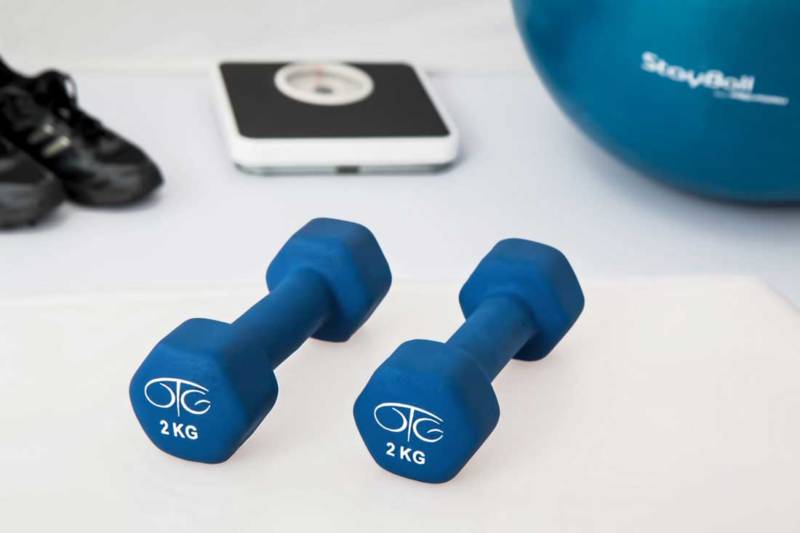
To begin your physical wellness journey and to live a healthy lifestyle, you must develop healthy habits. One of these healthy habits is exercising. Exercising regularly will help you feel better about yourself. Exercise looks different for everyone. You may choose to go for a walk everyday, or visit the gym a few times a week, or take part in an exercise class. Exercise has many benefits, including being healthy, feeling strong and having a positive attitude. It is important that you understand several elements of exercise before getting started with an exercise program.
Now, we will look closer at these four elements of exercise:
- Flexibility
- Strength
- Muscular endurance
- Cardiovascular endurance

Flexibility
Flexibility is the range of motion through which a person can move without strain or injury. With poor flexibility, you might experience aches, strains, or tears when you do simple things like get out of a chair quickly, get dressed, lean over a table, try to scratch your back or participate in sports. Poor flexibility can cause you to feel tight and tense rather than loose and comfortable. With flexibility, however, you will feel younger than you are and will be able to move when and how you want without fear of injury to muscles and joints.
Here are some tips to increase your flexibility:
- Move each body part through its full range of motion to protect and promote your flexibility. Keeping body parts flexible helps you keep the full use of your body.
- Stretch slowly and then hold the position. When you are working on flexibility, stretch slowly and hold the position at the extreme point of movement for five or more seconds.
- Avoid fast stretching and bouncing.
- Do flexibility exercises five to seven days per week.
- Use hot showers, baths or heat treatments prior to stretching for better results.

Strength
Strength is the ability to exert maximum force against an object of resistance in relation to one’s own body weight. With poor strength skills, you may have difficulty moving heavy objects or even getting out of a chair or car. You may have poor posture, tear muscles and joints while doing strenuous activities or be fearful of physical activity. With good strength skills, you have better muscle tone and firmness. You also have more energy. Strong muscles serve, along with flexibility, to maintain good posture.
Here are some tips for strength training:
- Warm up by stretching.
- Use a complete range of motion.
- Increase weight when you get to ten repetitions.
- Breathe in before; exhale after.
- Just three days per week with on day of rest in between

Muscular endurance
Muscular endurance is the ability of your muscles to endure prolonged activity that stresses localized muscular areas. It is the glue that holds together other dimensions of physical conditioning. It releases 20 different enzymes that attack fatty acids in the body and provides muscle definition as well as tone. The key to this type of exercise is repetition, which builds endurance for long, tiring work projects. Muscular aches during prolonged activity are symptoms that your muscles are being filled with blood and getting healthier.
The key to muscular endurance training is repetition, doing from 10 to 15 (and sometimes more) repetitions of a lift. Strength conditioning consists of up to 10 repetitions with a heavier weight. Muscular endurance training requires lighter weights but with more repetitions. Training with repetitions enables you to build endurance for repetitive physical effort in work and sports. In that sense, muscular endurance helps you take on and complete tiring, marathon-type projects without giving up midway through.
Here are some tips for muscular endurance:
- Warm up with flexibility exercises.
- Develop strength first, using your own body weight, then work on endurance.
- Work slowly and gradually.
- Begin with ten or more repetitions of a motion.
- To lose weight, increase repetitions and work out five or six days per week.
- Use full range of motion for each body part.
- Vary your routine.

Cardiovascular endurance
Cardiovascular endurance is the ability of your circulatory and respiratory systems to adjust to and recover with efficiency from the effect of prolonged exercise. It is the most important element in health-related fitness. Extensive research shows that having a high level of cardiovascular fitness decreases your chances of suffering from cardiovascular disease. Some examples of cardiovascular endurance activities are jogging, walking, swimming and cycling, which involve heavy breathing and perspiring. These aerobic exercises improve your body’s ability to use oxygen.
Here are some tips to keep in mind when practicing cardiovascular endurance:
- Warm up. Do stretching exercises at the start and at the finish.
- Learn how to monitor your heart rate.
- Go for six minutes or longer.
- Start slowly; increase the distance; then shorten the time gradually while increasing the distance. Stay in your training zone heart rate.
- For weight loss, slow down the activity, but increase the distance.
- Avoid smoking.
- Take sufficient fluids before and during exercise
- Exercise before eating, not after.
Thanks for tuning into our series on anxiety management and physical wellness. If you’d like to learn more about the importance of stress management and how The Anxiety Management Program works, download our PDF brochure here.
